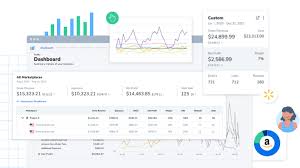Mastering Sales Analysis: A Comprehensive Guide to Analyzing Sales Data and Trends with Amazon’s Seller Central Tools

In the ever-evolving world of e-commerce, data is king. For sellers on Amazon, the ability to analyze sales data and trends is crucial for making informed decisions, optimizing performance, and driving growth. Fortunately, Amazon provides a suite of powerful tools and features within Seller Central to help sellers track and analyze their sales data effectively. In this extensive guide, we’ll explore the intricacies of analyzing sales data and trends using Amazon’s Seller Central tools, providing detailed explanations, practical strategies, and valuable insights to help sellers harness the power of data and drive success on the world’s largest online marketplace.
Understanding Sales Data Analysis on Amazon
Before delving into the specifics of analyzing sales data, it’s crucial to understand what it entails and why it matters:
- Performance Evaluation: Analyzing sales data allows sellers to evaluate the performance of their products, identify areas of strength and weakness, and make data-driven decisions to optimize performance.
- Identifying Trends: By tracking sales data over time, sellers can identify trends and patterns in customer behavior, market demand, and product performance, enabling them to capitalize on opportunities and adapt to changing market conditions.
- Informing Strategy: Sales data analysis provides valuable insights that can inform strategic decision-making, such as pricing strategies, inventory management, marketing campaigns, and product development initiatives.
Key Seller Central Tools for Sales Data Analysis
Amazon’s Seller Central offers a range of tools and features to help sellers analyze their sales data effectively:
- Sales Dashboard: The Sales Dashboard provides an overview of your sales performance, including metrics such as total sales, units sold, average selling price, and more.
- Sales Reports: Seller Central offers a variety of sales reports, including the Sales and Traffic report, which provides detailed insights into your sales performance, traffic sources, conversion rates, and more.
- Inventory Management Tools: Amazon’s inventory management tools allow sellers to track inventory levels, monitor sales velocity, and forecast demand to ensure optimal stock levels and prevent stockouts or overstock situations.
- Advertising Reports: For sellers running advertising campaigns on Amazon, the Advertising Reports dashboard provides valuable insights into campaign performance, including metrics such as ad spend, impressions, clicks, and conversion rates.
Strategies for Effective Sales Data Analysis
To maximize the benefits of sales data analysis and derive actionable insights from your data, consider implementing the following strategies:
- Set Clear Objectives: Before diving into your sales data, clearly define your objectives and key performance indicators (KPIs) to guide your analysis and ensure that you’re focusing on the metrics that matter most to your business.
- Track Key Metrics: Focus on tracking key metrics such as total sales, units sold, average selling price, conversion rate, and customer acquisition cost to gauge the overall health and performance of your business.
- Identify Trends and Patterns: Use sales data analysis to identify trends and patterns in customer behavior, market demand, and product performance, and use these insights to inform your strategic decision-making and planning.
- Monitor Competitor Performance: Keep an eye on your competitors’ sales data and performance metrics to identify opportunities, benchmark your performance, and stay ahead of the competition.
- Experiment and Iterate: Use sales data analysis to identify areas for improvement and experimentation, such as pricing strategies, product bundling, cross-selling opportunities, and marketing tactics, and iterate based on the results of your experiments.
Conclusion
Analyzing sales data and trends using Amazon’s Seller Central tools is a critical skill for sellers looking to succeed on the platform. By understanding the key tools and features available, setting clear objectives, tracking key metrics, and identifying trends and patterns in their data, sellers can make informed decisions, optimize performance, and drive growth for their businesses. So don’t miss out on the opportunity to harness the power of data and analytics to unlock new insights and opportunities for your Amazon business. Start analyzing your sales data today and take your business to new heights on the world’s largest online marketplace.




